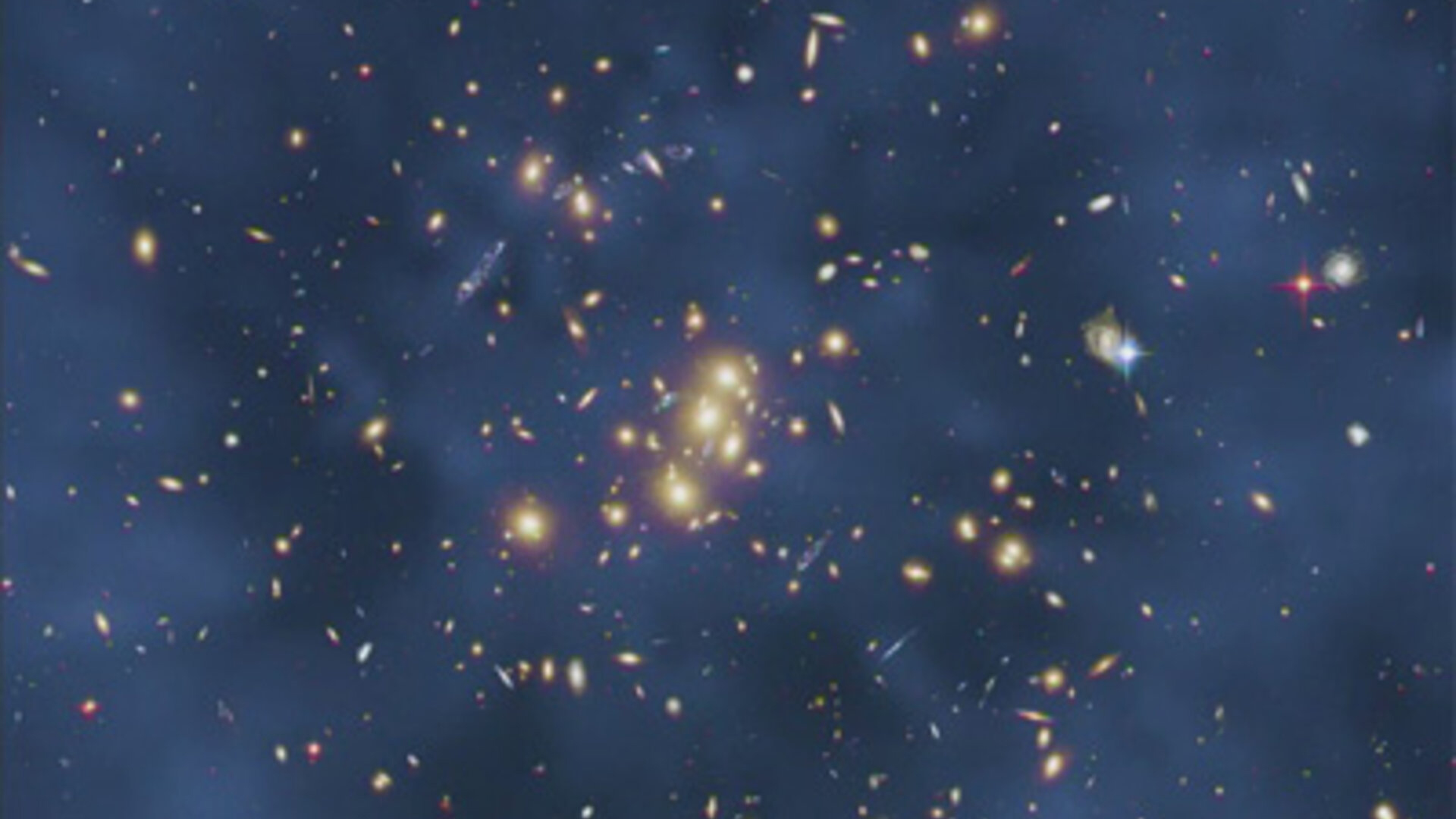Could the Large Hadron Collider discover dark matter?
The Large Hadron Collider's crowning glory was the discovery of the Higgs boson, but there's one thing that could usurp it: the discovery of dark matter.

With the switching back on of CERN's Large Hadron Collider (LHC) after a three-year hiatus, the giant particle accelerator has a new target set in its sights: the hunt for dark matter, the mysterious substance that must make up about 80% of all the matter in the universe, but which no one has ever seen.
It's an astounding fact that the vast majority of matter in the universe is actually invisible to us. Astronomers think that dark matter must be present because they see its gravitational fingerprints. Dark matter is the invisible cosmic scaffold that holds together galaxies and galaxy clusters. We just don't know what it is.
Intriguingly, experiments on the smallest scales at the Large Hadron Collider could hold the key to figuring out one of the largest-scale cosmological mysteries of all.
"Since the discovery of the Higgs boson, the field of dark matter has changed completely," Gian Guidice, who leads the theoretical division at CERN, told a press conference at the end of June.
Related: 10 cosmic mysteries the Large Hadron Collider could unravel
Ten years ago, the lead contender for the identity of dark matter was a class of particles known as weakly interacting massive particles, or WIMPS for short. These would be particles with large masses — hence dark matter's strong gravitational pull — but which otherwise would only weakly interact, or 'couple', with other particles.
"The experimental data from the LHC has since changed things," added Guidice. "Our new theoretical ideas have widened our horizons."
Breaking space news, the latest updates on rocket launches, skywatching events and more!
Now physicists are considering all manner of explanations for dark matter, including exotica such as a quasi-form of radiation called 'dark radiation' with wavelengths extending to several light-years, to mini-black holes, modified gravity, supersymmetric particles and other kinds of exotic matter.
"Dark matter has motivated a variety of new experimental techniques and channels that will be of great importance for the future," said Guidice.

Massive particles
Despite these new theories, it seems reasonable to still consider some type of particle as being a leading contender for the identity of dark matter.
"We think there has to be other particles that we haven't discovered yet, which aren't part of the Standard Model but which could make up dark matter," Victoria Martin, a professor of particle physics at the University of Edinburgh, Scotland, told Space.com.
The Higgs boson, discovered by the LHC ten years ago, could be the key. The Higgs boson is the mediator of the Higgs field, which is a universe-spanning field of energy from which massive particles draw their mass by interacting with the Higgs boson.
As we know, dark matter is extremely shy and retiring, only interacting with the rest of the universe through gravity. We can't see it otherwise, which makes detecting it a problem. If it is a WIMP, however, then it must surely get its mass from the same source as other massive particles, specifically, the Higgs field.
"We know that the Higgs boson interacts with everything that is heavy, so if dark matter is a heavy particle then the Higgs boson should be interacting with it," said Martin.
This propels the Higgs boson to the forefront of dark matter research, a probe into the dark realm that was impossible just 12 years ago, when the LHC was first switched on. The idea is that if dark matter is interacting with the Higgs field, then we might see through one of the LHC's experiments the Higgs boson decaying into dark matter.
Light dark matter
However, whereas once WIMPs were everybody's favorite explanation for dark matter, the possibility of lighter particles, such as hypothetical particles called axions, are now back on the drawing board.
"There's a huge range of masses that dark matter could have," Jamie Boyd, spokesperson for the LHC's FASER (Forward Search Experiment) instrument, told Space.com.
Suppose that the dark matter particle was a lighter particle such as an axion. It would require lots of these particles to fill the universe with all the dark matter that gravity suggests is there, and therefore the characteristics of a light dark matter particle would have to be very precise, with particular values for their mass and their coupling.
"FASER is looking at the light end of this, where the mass and coupling are small," said Boyd. "But what FASER looks for isn't so much the dark matter particle itself, but what we call its mediator."
Just as the Higgs boson mediates interactions between particles and the Higgs field, and photons allow the electromagnetic field to couple to particles, the dark matter mediator would allow dark matter to 'talk' to other particles in the standard model. Different types of mediators have been theorized, distinguished in part by their quantum spin, but the mediator that FASER is specifically tailored to detect is the hypothetical and mysterious-sounding 'dark photon'.
"The dark photon could be produced in the collisions in the LHC," said Boyd. As its name suggests, the dark photon would be extraordinarily difficult to detect directly. Instead, the idea is that after a dark photon has been produced in a collision between heavy ions in the LHC, the dark photon would subsequently enter the FASER instrument, where there is a chance it could interact with a dense tungsten target and decay into a bunch of ordinary standard model particles that FASER can more easily detect. Essentially, a bunch of standard model particles would appear to burst into existence out of thin air — they could be the smoking gun that a dark photon has slipped through undetected.
It's a long shot, but even a null result would provide valuable information to scientists. Theoretical predictions for the mass-energy of dark photons are quite wide; the LHC would be able to at least rule out large swathes of those possibilities, further constraining where the dark photon and dark matter particles might be hiding.
"It would be great if FASER discovered the dark photon, but if it were able to exclude parameter space where the dark photon may live, that would also be good," said Boyd.
The LHC is working in unison with astronomical observations that show the cosmic effects of dark matter, and these observations can then inform theoretical models, some of which can then be tested by the LHC — there's a lot of moving pieces to this puzzle.
Although nobody is entering this new LHC observing run expecting to definitively find dark matter, the new measurements are expected to help narrow the search for where dark matter might be hiding. And, if the LHC does discover dark matter, it would be the scientific discovery of the century. When future scientific historians look back on the LHC, they would no longer associate it with just the Higgs boson, but instead they would think of it as the instrument that finally brought light to the dark universe.
Follow Keith Cooper on Twitter @21stCenturySETI. Follow us on Twitter @Spacedotcom and on Facebook.

Keith Cooper is a freelance science journalist and editor in the United Kingdom, and has a degree in physics and astrophysics from the University of Manchester. He's the author of "The Contact Paradox: Challenging Our Assumptions in the Search for Extraterrestrial Intelligence" (Bloomsbury Sigma, 2020) and has written articles on astronomy, space, physics and astrobiology for a multitude of magazines and websites.
